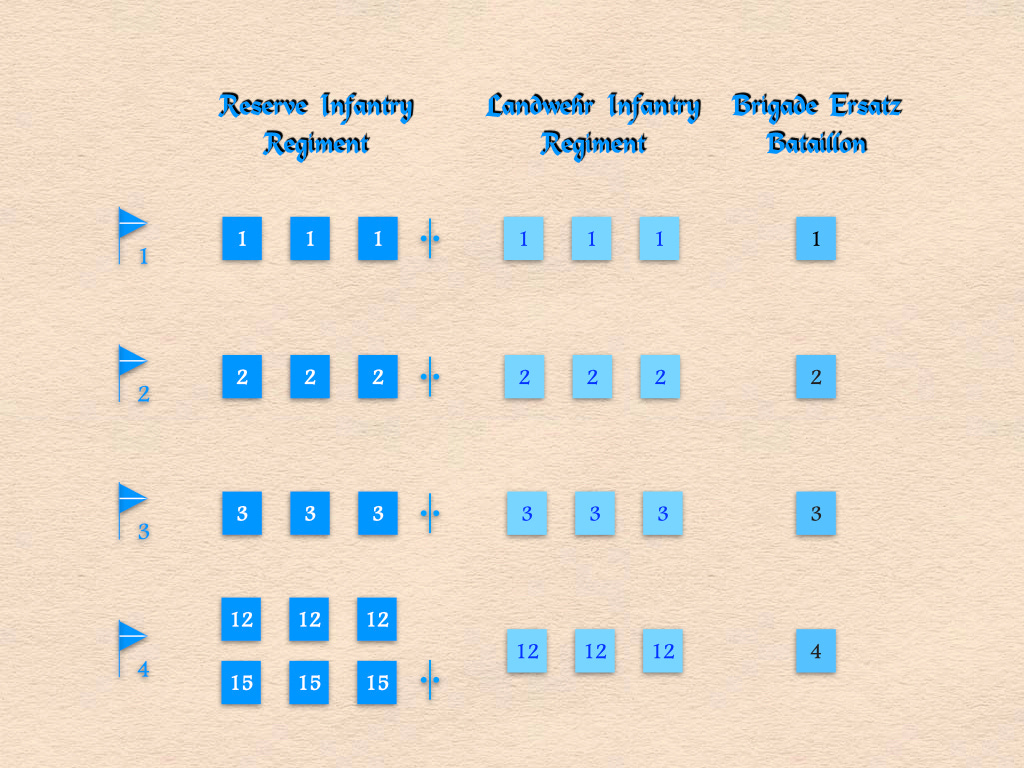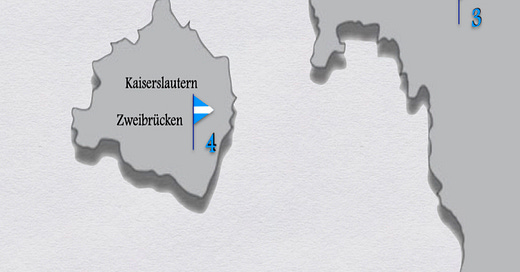In August of 1914, when the armies of the German Empire mobilized for war, the various arms and services employed a variety of methods to create second-line units. Jäger battalions “doubled” themselves. Most pioneer battalions split into two “field battalions,” each with different proportions of second-line troops. Infantry brigades created second-line units of three distinct types: a Reserve infantry regiment, a Landwehr infantry regiment, and a brigade Ersatz battalion.
In some cases, the actual mobilization of second-line units bore a close resemblance to the way this system was supposed to work. In other instances, the lack of necessary resources caused practice to diverge from theory. Examples of both phenomena can be seen in the way the three army corps of the Kingdom of Bavaria raised Reserve, Landwehr, and Ersatz infantry units.1
In the senior army corps of the Bavarian Army, the Royal Bavarian I Army Corps, there was very little difference between theory and practice.2 For each of the four infantry brigades of the peacetime army, the authorities who had remained at their home stations when the active units took the field raised a three-battalion Reserve infantry regiment, a three-battalion Landwehr infantry regiment, and a single brigade Ersatz battalion.
The Reserve and Landwehr infantry regiments took the number (but not the honorific titles) of one of the two peacetime regiments of the brigade that raised them. As a rule, the number given to the second-line regiments was that of the older of the two peacetime regiments. However, as the senior of the two regiments of the senior infantry brigade of the I Bavarian Army Corps was the Life Guard Regiment [Infanterie Leib-Regiment], the Reserve and Landwehr regiments of that brigade took the number of the junior regiment, the 1st Infantry Regiment. Thus, they became the 1st Reserve Infantry Regiment and the 1st Landwehr Infantry Regiment.
By chance, the senior regiments in two other infantry brigades of I Army Corps, the 2nd Infantry Regiment of the 2nd Infantry Brigade and the 3rd Infantry Regiment of the 3rd Infantry Brigade, bore the same number as their parent brigades. The senior regiment of the 4th Infantry Brigade, however, was the 12th Infantry Regiment. Thus, the 12th Reserve Infantry Regiment and 12th Landwehr Infantry Regiment carried the number of that regiment, and not the peacetime brigade that formed them.

The single glaring deficiency in the orders of battle of the second-line units of the I Bavarian Army Corps was the absence of the machine gun company that, according to the establishments in force at the time, the 12th Reserve Infantry Regiment was supposed to have formed.3 At the same time, the authorities left behind by the 4th Infantry Brigade raised another Reserve infantry unit. This organization, the 15th Reserve Infantry Regiment, consisted of three battalions and a machine gun company.
The two senior Landwehr regiments formed fourth battalions. These, classified as “immobile,” lacked the minimum number of horses and horse-drawn vehicles needed to take the field.4 (The two immobile battalions do not appear on the organizational diagram.)
The single most important published source on the subject of the mobilization of the Bavarian Army in 1914 is Karl Deuringer, Die Schlacht in Lothringen und in den Vogesen 1914: Die Feuertaufe der Bayerischen Armee [The Battle in Lorraine and the Vosges, 1914: The Baptism of Fire of the Bavarian Army] (Munich: Max Schick, 1929), Volume I. The facts gleaned from this volume were checked against the organizational appendix to the first volume of the German official history and Hermann Cron (C.F. Colton, translator) Imperial German Army: Organization, Structure, Orders-of-Battle (Solihull: Helion, 2002).
As every military organization mentioned in this post belonged to the army of the Kingdom of Bavaria, I have omitted “Royal Bavarian” [Königlich Bayerisch] from the names of units and formations.
Ernst Demmler, Das KB Reserve Infanterie Regiment 12 (Munich: Max Schick, 1934) page 19
Karl Hübel, Das KB Landwehr Infanterie Regiment Nr. 15 (Munich: Verlag der Bayerischen Kriegsarchiv, 1924) page 9




